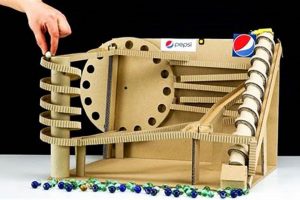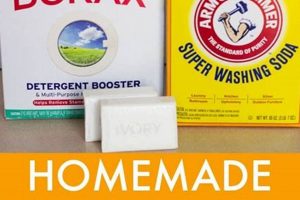The practice of performing vehicle alignment using self-fabricated or modified instruments constitutes a cost-effective alternative to professional services. This approach typically involves leveraging readily available materials and applying established principles of geometry to adjust wheel angles, ensuring proper tire contact and vehicle handling. For example, individuals may employ string, levels, and measuring tapes to replicate the functionalities of sophisticated alignment machines found in automotive repair shops.
Precise wheel alignment significantly impacts vehicle performance, tire lifespan, and fuel efficiency. Historically, rudimentary methods were the only option, evolving alongside automotive technology. Today, even with advanced diagnostic tools available, the appeal of independent alignment persists due to the potential for substantial cost savings and the satisfaction derived from hands-on vehicle maintenance. The ability to fine-tune a vehicle’s handling characteristics to personal preferences also contributes to its continued relevance.
The subsequent sections will delve into the specific types of tooling employed, the methodologies involved in achieving accurate alignment, and the potential risks and rewards associated with this approach.
Tips for Effective DIY Alignment
Achieving accurate vehicle alignment through self-administered methods requires meticulous attention to detail and a thorough understanding of automotive geometry. The following tips offer guidance for optimal results.
Tip 1: Prioritize accurate measurements. The foundation of any successful alignment procedure rests on precise data acquisition. Utilize calibrated measuring devices and ensure proper setup to minimize error. A discrepancy of even a few millimeters can significantly impact vehicle handling.
Tip 2: Employ a level surface. Conduct alignment procedures on a flat, even surface to prevent skewed readings. A garage floor is often not sufficiently level; consider using shims or leveling compounds to create a suitable working area.
Tip 3: Understand vehicle specifications. Consult the vehicle’s service manual to obtain the factory-recommended alignment specifications. These parameters provide the target values for toe, camber, and caster, ensuring optimal performance and tire wear.
Tip 4: Check for worn components. Before initiating alignment adjustments, inspect suspension and steering components for excessive wear or damage. Replacing worn parts is crucial, as attempting to align a vehicle with faulty components will yield inaccurate and short-lived results.
Tip 5: Use proper tools. Improvised tools can compromise accuracy. While complete professional alignment systems may not be necessary, investing in basic, reliable tools designed for measuring angles and distances will improve the quality of the work.
Tip 6: Double-check adjustments. Following each adjustment, verify the alignment readings to confirm that the desired specifications have been achieved. Multiple iterations may be necessary to fine-tune the alignment accurately.
Tip 7: Document all settings. Record the initial and final alignment readings to track progress and facilitate future adjustments. This documentation provides a valuable reference point for identifying potential issues and optimizing alignment settings.
Adhering to these guidelines significantly increases the likelihood of achieving accurate and durable alignment results. By understanding the underlying principles and employing careful techniques, it is possible to realize the benefits of a well-aligned vehicle, including improved handling, extended tire life, and enhanced fuel efficiency.
The subsequent discussion will address potential challenges and safety considerations associated with the practice.
1. Tooling Precision
The accuracy of results achieved with self-fabricated or adapted vehicle alignment instruments is directly contingent upon the precision of the chosen tooling. Inadequate precision in measurement devices introduces systematic errors, leading to improper wheel alignment angles. For example, a spirit level with a poorly calibrated bubble, when employed to measure camber, will yield inaccurate readings, resulting in uneven tire wear and compromised vehicle handling. The use of string lines to determine toe-in or toe-out is another case. Inconsistencies in string thickness or tension, coupled with imprecise measurement techniques, can generate significant deviations from optimal alignment settings. As a result, the perceived cost savings derived from utilizing self-fabricated alignment methods may be offset by the expense of premature tire replacements and compromised fuel efficiency.
The impact of tooling precision extends beyond simple linear measurements. Angular measurements, crucial for setting camber and caster, necessitate specialized instruments. Digital angle finders offer a more precise alternative to traditional protractors but require calibration to ensure accuracy. In instances where cost is a primary concern, meticulously fabricated jigs or fixtures can improve accuracy. However, the time and skill required to construct such jigs may render this approach impractical for some individuals. Furthermore, it is important to consider the limitations of improvised tools when working with vehicles equipped with advanced suspension systems, as the tolerances for alignment settings are often tighter.
In summary, the selection and proper utilization of precision tools are paramount to the success of self-administered vehicle alignment. The absence of precision introduces errors that negate the potential benefits of such procedures. While cost-effective solutions exist, compromising on accuracy can lead to more significant financial burdens in the long run. Therefore, a careful assessment of available tooling options and a thorough understanding of measurement techniques are essential to achieving satisfactory alignment results.
2. Surface Leveling
Surface leveling forms a foundational component in the successful implementation of self-executed vehicle alignment adjustments. The principle rests on the understanding that accurate measurements of wheel anglestoe, camber, and casterare predicated on a consistent gravitational reference plane. Without a level surface, gravity’s influence introduces artificial inclination, skewing measurement data and leading to incorrect alignment settings. For instance, a vehicle resting on an uneven surface will exhibit falsely inflated or deflated camber readings, causing the subsequent adjustments to compound the error rather than correct it. A common example illustrates this: attempting to align a vehicle on a garage floor with a slight slope can result in a “dog tracking” condition, where the rear wheels do not follow the same path as the front wheels, causing accelerated tire wear and compromised handling.
The practical implications of inadequate surface leveling are significant. Errors introduced at this stage propagate throughout the entire alignment procedure, rendering even the most precise instruments ineffective. Furthermore, adjustments made based on flawed data can lead to unintended consequences, such as steering wheel misalignment, reduced fuel efficiency, and compromised vehicle stability. Addressing this challenge requires careful evaluation of the working area. Simple spirit levels or laser levels can be employed to identify and quantify surface irregularities. Corrective measures may involve shimming the vehicle’s wheels with calibrated plates or, ideally, relocating the alignment procedure to a more level location. In cases where a perfectly level surface is unattainable, adjustments to measurement data may be necessary to compensate for the existing inclination; however, this approach demands a thorough understanding of trigonometric principles and vehicle geometry.
In conclusion, surface leveling is not merely a preliminary step in DIY alignment, but rather an integral factor influencing the accuracy and validity of the entire process. The inherent complexities associated with achieving and maintaining a level reference plane highlight the challenges associated with self-administered alignment procedures. Ignoring this fundamental requirement often results in outcomes that are detrimental to vehicle performance and safety, ultimately undermining the objective of cost-effective vehicle maintenance.
3. Measurement Accuracy
The degree to which DIY alignment tools yield effective results is intrinsically linked to the accuracy of the measurements they facilitate. Errors introduced during the measurement phase propagate through the subsequent adjustment process, potentially compromising vehicle handling, tire wear, and overall safety. Therefore, a critical assessment of measurement accuracy is paramount when considering the use of self-administered alignment methods.
- Instrument Calibration
The inherent precision of measurement devices, such as levels, angle finders, and measuring tapes, directly impacts the reliability of alignment data. Calibration ensures that instruments provide readings within acceptable tolerances. Uncalibrated or poorly calibrated tools introduce systematic errors, undermining the validity of alignment adjustments. For example, an angle finder with a skewed zero-point will consistently misreport camber angles, leading to incorrect adjustments and uneven tire wear.
- Methodological Errors
Regardless of the tool’s inherent precision, improper measurement techniques introduce significant inaccuracies. Parallax errors when reading scales, inconsistent string tension when measuring toe, and incorrect positioning of measurement devices all contribute to methodological errors. These errors are particularly prevalent in DIY settings, where individuals may lack the training and experience necessary to employ proper measurement protocols. The cumulative effect of these errors can negate the benefits of even the most sophisticated alignment tools.
- Environmental Factors
External conditions, such as uneven surfaces, temperature fluctuations, and ambient lighting, can influence measurement accuracy. An uneven surface, as previously discussed, introduces artificial inclination, distorting angular measurements. Temperature variations affect the dimensions of measurement devices, altering their calibration. Inadequate lighting hinders precise readings. Mitigating these environmental factors requires careful attention to the setup and execution of alignment procedures.
- Human Error
Human error represents a persistent source of measurement inaccuracy. Misreading scales, incorrectly recording data, and making calculation errors all contribute to deviations from optimal alignment settings. Mitigating human error involves implementing standardized procedures, double-checking measurements, and employing data logging tools to minimize transcription errors. The adoption of these strategies is critical for achieving reliable and consistent alignment results.
The collective influence of instrument calibration, methodological errors, environmental factors, and human error underscores the inherent challenges associated with achieving accurate measurements using DIY alignment tools. While these tools offer a cost-effective alternative to professional services, a thorough understanding of potential error sources and the implementation of rigorous measurement protocols are essential for realizing their full potential and avoiding potentially detrimental consequences.
4. Vehicle specifications
Adherence to vehicle specifications is paramount when employing self-fabricated or adapted vehicle alignment instruments. These specifications, typically outlined in the vehicle’s service manual, dictate the precise angular relationships between the wheels and the vehicle’s chassis. Failure to align a vehicle within these parameters directly affects handling characteristics, tire wear patterns, and overall vehicle safety. For instance, if a vehicle manufacturer specifies a camber angle of -0.5 degrees for optimal tire contact, deviating significantly from this setting using improvised alignment methods can lead to premature wear on the inner or outer edges of the tires. This not only increases operational costs but also compromises the vehicle’s ability to maintain traction under various driving conditions. Therefore, vehicle specifications serve as the definitive guidelines against which the accuracy of DIY alignment tools and procedures must be measured.
The practical application of vehicle specifications in conjunction with DIY alignment tools necessitates a thorough understanding of their meaning and the potential consequences of deviations. Specifications for toe, camber, and caster angles are interdependent, and adjusting one without considering the others can create unintended side effects. For example, correcting toe-in without verifying camber can mask an underlying suspension issue, leading to continued tire wear despite the adjustment. Furthermore, different vehicle models and trim levels often have varying alignment specifications due to differences in suspension geometry and intended use. Consulting the correct service manual and identifying the specific alignment settings for the vehicle in question are crucial steps before initiating any DIY alignment procedure. Utilizing readily available tools without this information increases the risk of improper alignment and potentially dangerous driving conditions.
In conclusion, vehicle specifications provide the essential framework for achieving accurate and safe alignment adjustments using self-administered methods. The inherent limitations of DIY alignment tools underscore the importance of diligently adhering to these specifications. While the allure of cost savings may motivate individuals to undertake DIY alignment, neglecting the foundational role of vehicle specifications can lead to outcomes that are both economically unsound and potentially hazardous. Prioritizing the acquisition and comprehension of vehicle-specific alignment parameters is a prerequisite for anyone considering the use of DIY alignment tools.
5. Adjustment Methodology
The effectiveness of self-fabricated vehicle alignment instruments hinges significantly on the adjustment methodology employed. The process by which wheel angles are altered directly influences the final alignment precision, thereby impacting vehicle handling, tire wear, and fuel efficiency. DIY alignment tools, regardless of their sophistication, are merely instruments; the technique with which they are used dictates the outcome. For example, a rudimentary string alignment setup can yield acceptable results if meticulous adjustments are made incrementally and systematically, while a more advanced bubble level system can produce inaccurate results if adjustments are performed haphazardly without consistent verification.
Practical applications of adjustment methodology encompass several critical aspects. One concerns the sequence of adjustments. Typically, camber and caster are addressed before toe, as altering camber or caster can affect toe settings. Another aspect relates to the incremental nature of adjustments. Fine-tuning alignment angles requires small, deliberate adjustments followed by thorough verification using the chosen DIY tools. This iterative process minimizes the risk of over-correction and allows for precise alignment within the vehicle manufacturer’s specified tolerances. Furthermore, proper methodology includes accounting for suspension settling. After each adjustment, the vehicle should be gently rocked or driven a short distance to allow the suspension to settle into its new configuration before re-measuring the alignment angles.
In summary, the adjustment methodology constitutes a pivotal component of the DIY alignment process. While the availability of self-fabricated tools provides a cost-effective alternative to professional services, their efficacy is inextricably linked to the skill and diligence with which adjustments are executed. A systematic, incremental, and iterative approach, coupled with a thorough understanding of vehicle alignment principles, is essential for achieving satisfactory and safe alignment results using DIY methods.
6. Component condition
The condition of suspension and steering components exerts a direct and substantial influence on the efficacy of self-executed vehicle alignment using DIY instruments. Worn or damaged components introduce instability and play into the precision and validity of alignment adjustments. For instance, worn ball joints or tie rod ends exhibit excessive play, which prevents accurate measurement and secure fixing of wheel alignment angles. An attempt to align a vehicle with such worn components often results in a temporary alignment that quickly degrades as the worn parts shift and settle during normal driving. Consequently, resources and time spent on self-executed alignment become ineffective without addressing underlying mechanical deficiencies.
A practical example of this interconnectedness is observable when attempting to correct camber using DIY methods on a vehicle with weakened strut mounts. Even if initial camber readings appear within acceptable range after adjustment, the compromised strut mounts may continue to deform under load, causing the camber angle to deviate over time. Similarly, bent control arms or damaged suspension bushings alter the vehicle’s suspension geometry, invalidating the initial alignment settings. In these cases, investing in new alignment tooling or techniques yields limited benefits; prioritizing the replacement of worn or damaged suspension components is a fundamental prerequisite for achieving a stable and lasting alignment. Without proper care, adjustments made might create dangerous driving conditions or create instability for the driver or vehicle.
In summary, successful application of DIY alignment hinges on addressing the component condition of the vehicle’s suspension and steering systems. Accurate alignment using self-fabricated instruments is contingent upon the integrity of these components. Ignoring the condition of critical parts results in unstable adjustments and compromises vehicle safety. A comprehensive inspection and necessary repairs or replacements must precede any attempt at DIY alignment to realize the intended benefits of improved handling, prolonged tire life, and enhanced fuel efficiency.
7. Safety precautions
The integration of safety precautions within the domain of DIY alignment tools is not merely advisable but fundamentally critical. This connection stems from the inherent risks associated with working on vehicles, often involving lifting heavy machinery, manipulating potentially hazardous tools, and working in close proximity to components under stress. A failure to adhere to established safety protocols can result in serious injury or even fatal accidents. For example, improperly secured vehicles can fall from jacks, causing severe crushing injuries. Similarly, the misuse of tools can lead to lacerations, fractures, or eye injuries. The importance of safety precautions, therefore, transcends mere recommendations and constitutes an indispensable component of any DIY alignment endeavor.
Practical application of safety principles in DIY alignment necessitates a multi-faceted approach. Firstly, the use of appropriately rated and properly maintained safety equipment is paramount. Jack stands, wheel chocks, and safety glasses should be employed without exception. Secondly, a thorough understanding of the vehicle’s lifting points and the safe operation of tools is essential. Consultation of the vehicle’s service manual and careful adherence to manufacturer’s instructions are crucial steps. Thirdly, maintaining a clean and organized workspace minimizes the risk of trips, falls, and accidental tool damage. These measures, while seemingly basic, significantly mitigate the potential for injury and contribute to a safer working environment. A real-world example is the implementation of a “buddy system,” where another individual is present during the alignment process to provide assistance and monitor for potential hazards.
In conclusion, the inherent link between safety precautions and DIY alignment tools underscores the importance of prioritizing safety above all else. The potential consequences of neglecting safety protocols range from minor injuries to severe accidents, highlighting the need for meticulous adherence to established guidelines. While DIY alignment offers a cost-effective alternative to professional services, it should never come at the expense of personal safety. A comprehensive understanding of safety principles, coupled with the diligent application of appropriate safety measures, is indispensable for a successful and injury-free DIY alignment experience. Neglecting this understanding could nullify any financial benefit while increasing the risk of harm.
Frequently Asked Questions
The following questions address common concerns and misconceptions surrounding the use of self-fabricated or adapted tools for vehicle alignment purposes. This information aims to provide clarity and promote safe practices within this domain.
Question 1: How accurate can alignment be when using DIY alignment tools?
The accuracy attainable with DIY alignment tools depends heavily on several factors, including the precision of the tools themselves, the meticulousness of the user, and the prevailing environmental conditions. W
hile achieving factory-level precision may prove challenging, experienced individuals employing calibrated instruments and following established procedures can often attain acceptable results for everyday driving conditions. However, it is essential to acknowledge that DIY methods may not be suitable for vehicles requiring exceptionally tight alignment tolerances or those subjected to demanding performance applications.
Question 2: What are the primary risks associated with using DIY alignment tools?
The primary risks associated with employing DIY alignment tools stem from potential inaccuracies, improper vehicle support, and insufficient understanding of vehicle suspension systems. Incorrect adjustments can lead to accelerated tire wear, compromised handling, and reduced fuel efficiency. Furthermore, working under a vehicle supported only by a jack poses a severe safety hazard. A lack of familiarity with suspension components can result in improper adjustments or damage to critical systems.
Question 3: What essential tools are required for a basic DIY alignment?
A basic DIY alignment typically requires a level surface, accurate measuring devices (such as a digital angle finder or bubble level), string or measuring tape, wrenches suitable for adjusting tie rods and control arms, and a reliable jack and jack stands for safely lifting and supporting the vehicle. Access to the vehicle’s service manual, detailing the manufacturer’s alignment specifications, is also essential.
Question 4: How often should a vehicle’s alignment be checked when using DIY methods?
Vehicles aligned using DIY methods should be checked more frequently than those aligned professionally. A visual inspection of tire wear patterns should be conducted regularly. A complete alignment check is recommended after any significant impact with potholes or curbs, or if any changes in handling characteristics are observed. A general recommendation is to check alignment every 3,000-6,000 miles.
Question 5: Can DIY alignment tools be used on all vehicle types?
While DIY alignment tools can theoretically be used on a wide range of vehicle types, their suitability depends on the complexity of the suspension system and the required alignment precision. Vehicles with advanced suspension systems, such as those incorporating electronic stability control or adaptive dampers, may necessitate specialized alignment equipment and expertise beyond the scope of DIY methods. Older vehicles with simpler suspension designs may be more amenable to DIY alignment.
Question 6: How does one determine if a DIY alignment attempt has been successful?
The success of a DIY alignment attempt can be assessed through a combination of objective measurements and subjective observations. Objective measurements include verifying that toe, camber, and caster angles fall within the manufacturer’s specified tolerances. Subjective observations involve evaluating vehicle handling characteristics, such as straight-line tracking, steering wheel centering, and the absence of excessive tire noise. Uneven tire wear is a long-term indicator of alignment issues.
The informed and cautious application of self-fabricated alignment practices can afford financial and functional benefit. However, a thorough understanding of vehicle dynamics and safety procedure is paramount.
The following section will describe common “diy alignment tools” available.
Conclusion
This exploration of DIY alignment tools has highlighted the potential benefits and inherent risks associated with their use. Achieving accurate and safe alignment through self-administered methods necessitates a comprehensive understanding of vehicle dynamics, meticulous adherence to safety protocols, and the application of precise measurement techniques. The selection of appropriate tools, accounting for tooling precision and proper calibration, remains a critical factor. Furthermore, the condition of suspension components and the establishment of a level working surface exert significant influence on the final results. Ultimately, successful implementation depends on a systematic approach, careful verification, and consistent monitoring of tire wear patterns.
The decision to employ DIY alignment tools should be predicated on a careful assessment of one’s technical capabilities, available resources, and the specific requirements of the vehicle in question. While the allure of cost savings is undeniable, the potential consequences of improper alignment necessitate a cautious and informed approach. Further research and continuous learning are encouraged to maximize the benefits and minimize the risks associated with this practice. Prioritizing safety and accuracy should remain paramount throughout any self-administered alignment endeavor.







